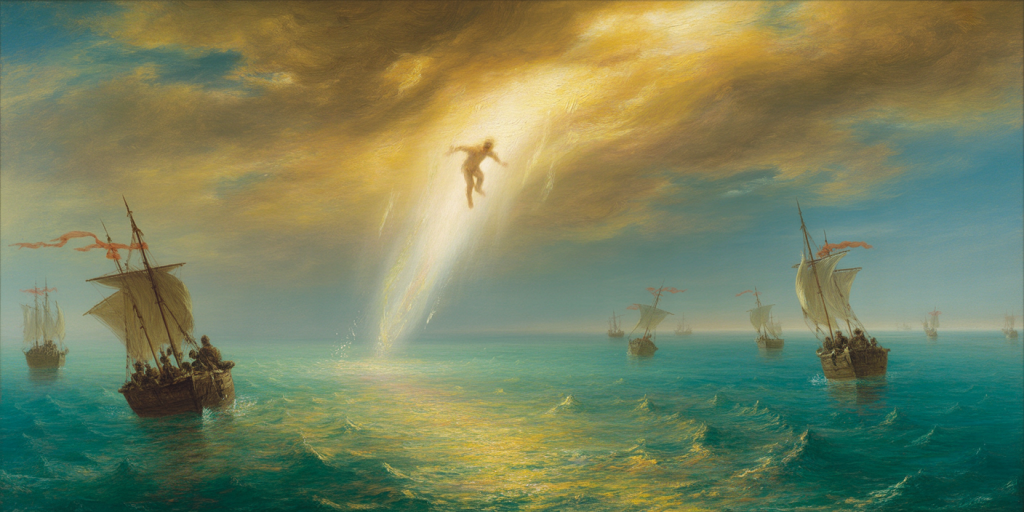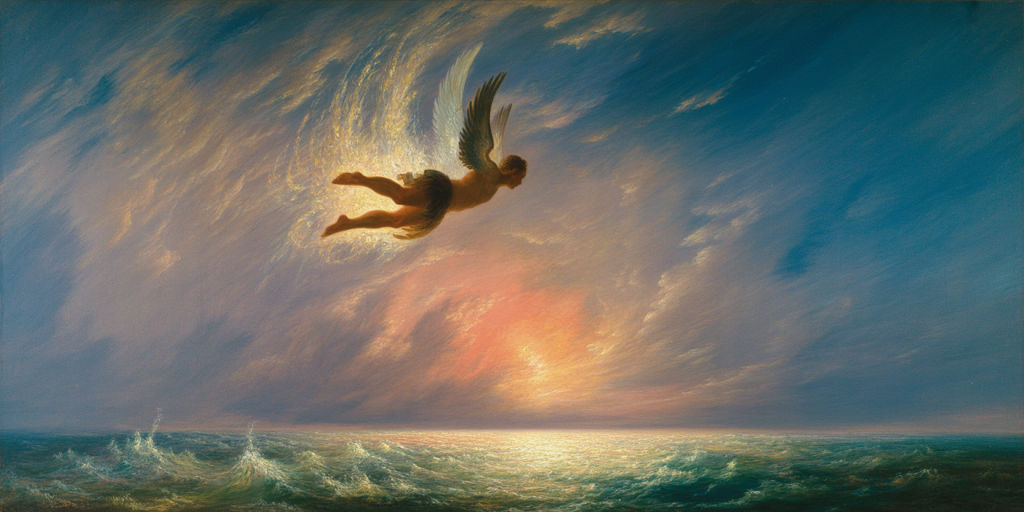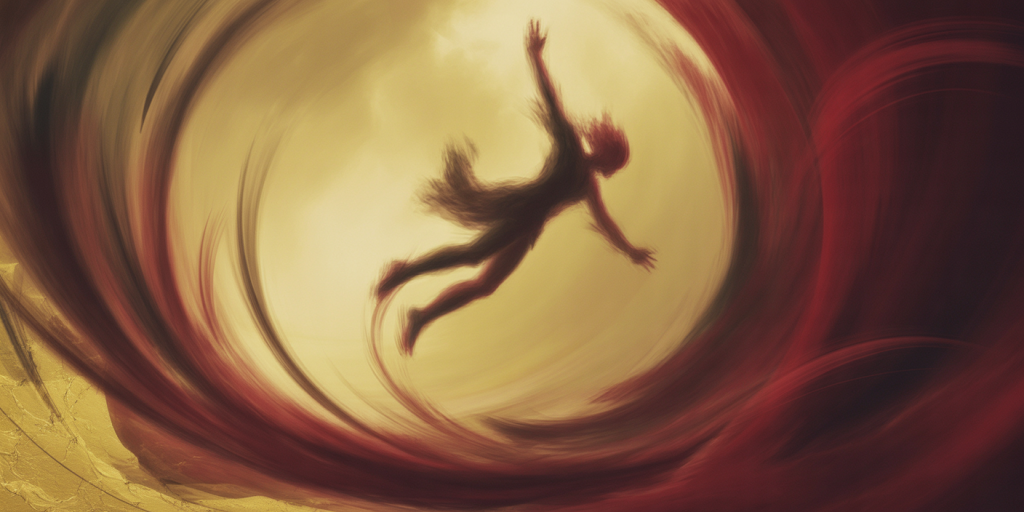The Gods Depart: Turner and the Luminous Fall of Icarus
A flame falls through a sky of trembling gold. It is not a star, nor a sun, but a boy with waxen dreams, plummeting not only from height, but from myth itself. Around him, the heavens dissolve into color, sea into light, and the divine into silence. J. M. W. Turner does not paint Icarus as a figure—he paints him as a force, a shimmer, a sorrow made incandescent.
Where others give the fall of Icarus a tragic shape, Turner gives it a temperature, a hue, a motion. His brush moves not on canvas but on atmosphere. Through mist and fire, through vapor and vortex, the story becomes not a tale but a sensation. A golden collapse, a divine departure, a hymn to the mortal flare.
Table of Contents
- Wings That Burn in Silence
- The Horizon Where Gods Vanish
- Pigments of Hubris
- Between Radiance and Ruin
- The Melt of Heaven
- A Boy Dissolving into Atmosphere
- Seafoam and Sorrow
- Spirals of Sacrifice
- When Sky Becomes Grief
- The Invisibility of Falling
- Echoes in the Mist
- Light as a Wound
- Shipwrecks of the Soul
- Luminous Disobedience
- Gravity in Gold
- Water That Remembers Fire
- The Last Flight Streaked in Color
- Turner’s Eye and the Mythic Blur
- A Theology of Evaporation
- The Silence After the Gods Depart
Wings That Burn in Silence
Turner does not show the scream. There is no shattering sound. Icarus falls in silence, swallowed by light, by distance, by sea. His wings, if seen at all, are spectral smears in the sky’s trembling palette.
This silence is more haunting than lament. It is the silence of divine indifference, of a cosmos too vast to notice the fall of one bright soul. Turner paints that silence in light—the kind that doesn’t warm, only blinds.
The Horizon Where Gods Vanish
The horizon in Turner’s work is never solid. It shimmers, bends, exhales. It is not a boundary, but a dissolution. Icarus does not fall toward the earth, but away from Olympus, away from the fire that once named him myth.
In this horizon, gods do not rage—they fade. Their absence is luminous. The viewer senses the moment just after abandonment, when the heavens no longer watch, and the mortal must descend alone.
Pigments of Hubris
Turner’s palette for this scene is not heroic. It is reckless. Golds melt into oranges that threaten crimson, clouds boil in pewter and flame. These are not the hues of glory but of consequence.
Hubris in Turner is not punished—it combusts. Icarus, as light, is his own execution. The pigment trails him like smoke, like memory. The very act of flying too close is rendered in irreversible color.
Between Radiance and Ruin
The central tension of the piece lies in this twilight: the radiant and the ruined indistinguishable. Turner refuses to let us know if this is the peak or the plunge. The sun itself seems complicit, unsure if it is burning Icarus or blessing him.
In this uncertainty lies a deeper truth. Radiance and ruin are not opposites but twins. To blaze is to risk dissolution. Turner lets the viewer hang in that incandescent ambiguity.
The Melt of Heaven
Sky, in Turner’s hand, becomes a fluid. He melts heaven like wax, letting light and cloud and motion drip into one another. The divine, here, is not eternal—it is fugitive.
As Icarus falls, heaven itself unravels. Not as judgment, but as participation. The gods are not above—they are within the disintegration. They dissolve with their fallen child.
A Boy Dissolving into Atmosphere
There is no clear figure of Icarus in the traditional sense. Turner paints him as an echo, a vibration, a vanishing. We feel him more than we see him—trailing light, disturbing waves, staining the sky.
This is a boy not dying but transfiguring. His fall becomes a weather event, a change in pressure, a shift in the air’s golden weight. It is intimate and cosmic all at once.
Seafoam and Sorrow
The sea below is not passive. It churns like mourning made physical. Its colors—bruised, silvered, verdant—mirror the chaos above, yet it remains the inevitable end of the arc.
Foam flickers like laughter at a funeral. Sorrow in Turner is not weeping—it is sprawling, tidal, eternal. The sea does not catch Icarus. It absorbs him.
Spirals of Sacrifice
The composition curls inward, a spiral of light pulling the eye—and the boy—downward. This vortex is not only physical but spiritual. It is a gesture of sacrifice made visible.
Like Dante’s descent or Blake’s whirlwinds, the fall here is architectural, almost liturgical. Turner turns tragedy into liturgy, brushstroke into requiem.
When Sky Becomes Grief
The clouds do not frame the event—they are the event. Their softness contradicts their weight. They hang with the burden of all that has ever tried to fly.
Light seeps from them not as grace, but as farewell. In Turner’s sky, grief does not darken—it glows. Each billow is a breath withheld, each shaft a memory evaporating.
The Invisibility of Falling
We look, but we do not find Icarus immediately. He resists focus. This is intentional. Turner paints him into invisibility, suggesting that all great falls are unnoticed until the splash is gone.
This invisibility is thematic. It is the anonymity of ambition in a world too vast. It is the truth that gods depart quietly, and boys fall without eulogy.
Echoes in the Mist
Mist curls around the scene like memory. It softens form, erases clarity. This is not the blur of laziness, but of mourning. Turner uses mist to show the mind’s inability to hold on to a moment as it burns away.
What remains is impression, not image. The echo of the fall, not its outline. A memory of brilliance, not its evidence.
Light as a Wound
Light in Turner is not healing—it wounds. It exposes what cannot be touched. The golden flare in this painting is a scar across vision. We wince before we admire.
It is a baptism by fire with no redemption. In this light, Icarus is consecrated and consumed. The viewer too is branded.
Shipwrecks of the Soul
Below the celestial drama, ships drift. Barely visible, they continue undisturbed. These are the lives that go on, the people who do not see the fall.
This contrast is brutal. The mythic collapse occurs amid the mundane. Turner insists: even the fall of Icarus cannot stop the tide, the trade, the tedium of the world.
Luminous Disobedience
Icarus’s flight was a rebellion. Turner paints it not as folly but as brilliance—dangerous, yes, but necessary. The color explodes not in mockery, but in homage.
Disobedience, in this context, is divine. The son disobeys the father, the wax disobeys the sun. Yet in doing so, he becomes light. The fall is his freedom.
Gravity in Gold
Gold, that eternal symbol of gods and kings, becomes gravity itself in Turner’s hands. It pulls Icarus downward not with weight, but with beauty.
There is seduction in the descent. The gold is not a punishment, but a final embrace. It cloaks him as he dies. It sings him into the sea.
Water That Remembers Fire
Even after Icarus is gone, the water remembers. Its shimmer echoes the sky’s former blaze. Reflections flicker like ghost flames.
Turner lets the sea become a mirror of myth. It does not forget. Every ripple is a whisper. Every wave, a hymn to wings.
The Last Flight Streaked in Color
The final motion of Icarus is not a fall, but a streak—color dragged across sky and thought. He becomes less body, more brushstroke.
This is the essence of Turner: motion without borders, emotion without figure. Icarus’s last act is to become color. He does not vanish. He becomes paint.
Turner’s Eye and the Mythic Blur
Turner’s genius lies in his blur—not as indecision, but as transcendence. He sacrifices clarity for awe, edges for experience. The myth dissolves to make room for the viewer’s own fall.
Blurring becomes theology. In the indistinct, we feel more deeply. In the undefined, we find ourselves.
A Theology of Evaporation
This is not the painting of a death, but of a departure. Icarus evaporates—into light, into legend, into Turner’s own longing for the unreachable.
The gods, too, do not descend. They thin into the horizon, bleed into the palette. Turner’s theology is one of fading, of holiness that lingers only as afterglow.
The Silence After the Gods Depart
What remains is quiet. A sea without splash. A sky without cry. The gods have left, and the boy is gone. Only light and pigment mourn.
In that silence, the viewer hears the truth: that beauty falls, that myths fade, and that art alone can catch the last golden trace.

FAQ
Who was J. M. W. Turner?
Joseph Mallord William Turner (1775–1851) was an English Romantic painter known for his expressive use of color, atmospheric landscapes, and pioneering approach to light and abstraction.
Did Turner ever paint Icarus directly?
While Turner never explicitly titled a work after Icarus, many interpret certain seascapes and luminous skies as metaphorical representations of the myth, reflecting his interest in human fragility and nature’s immensity.
What distinguishes Turner’s style in this context?
Turner dissolves form into feeling. His brushwork captures motion and mood over detail, using light and color to evoke emotional and symbolic weight.
Why is Icarus relevant to Turner’s themes?
Icarus embodies ambition, disobedience, and downfall—all central to Turner’s Romantic ideals. His fall is a metaphor for human striving against cosmic indifference.
What emotions does this interpretation aim to provoke?
Awe, melancholy, reverence, and the sublime sensation of witnessing beauty at the edge of destruction.
Final Reflections: The Echo Made of Light
To gaze upon Turner’s fall of Icarus is to witness the divine undone not in fury, but in radiance. It is to see the last breath of a godlit dream, captured not in figure, but in the trembling between gold and sea.
This is not a painting of a myth—it is the myth remembering itself as it disappears. Turner does not save Icarus. He sanctifies the fall. In blur and blaze, in silence and shimmer, he leaves us not with the boy, but with his echo.
An echo made of light.


